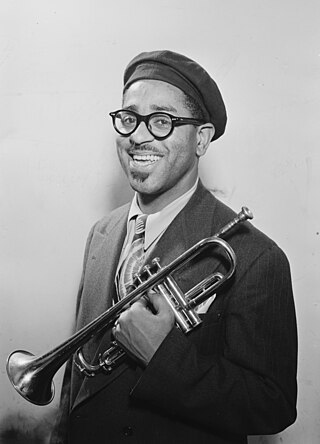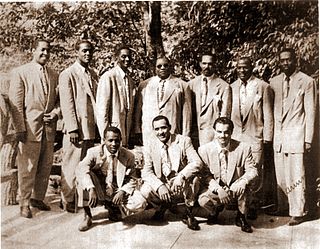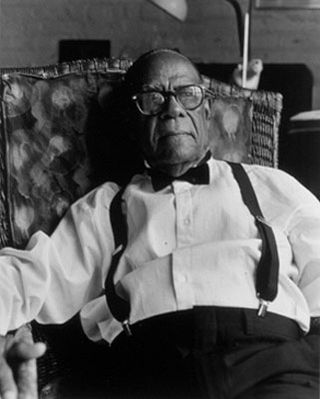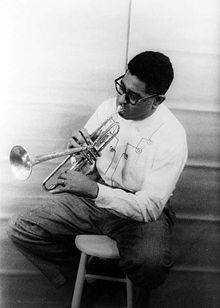Jazz is a music genre that originated in the African-American communities of New Orleans, Louisiana, in the late 19th and early 20th centuries, with its roots in blues, ragtime, European harmony, African rhythmic rituals, spirituals, hymns, marches, vaudeville song, and dance music. Since the 1920s Jazz Age, it has been recognized as a major form of musical expression in traditional and popular music. Jazz is characterized by swing and blue notes, complex chords, call and response vocals, polyrhythms and improvisation.

Bebop or bop is a style of jazz developed in the early to mid-1940s in the United States. The style features compositions characterized by a fast tempo, complex chord progressions with rapid chord changes and numerous changes of key, instrumental virtuosity, and improvisation based on a combination of harmonic structure, the use of scales, and occasional references to the melody.

John Birks "Dizzy" Gillespie was an American jazz trumpeter, bandleader, composer, educator and singer. He was a trumpet virtuoso and improviser, building on the virtuosic style of Roy Eldridge but adding layers of harmonic and rhythmic complexity previously unheard in jazz. His combination of musicianship, showmanship, and wit made him a leading popularizer of the new music called bebop. His beret and horn-rimmed spectacles, scat singing, bent horn, pouched cheeks, and light-hearted personality have made him an enduring icon.
Latin jazz is a genre of jazz with Latin American rhythms. The two main categories are Afro-Cuban jazz, rhythmically based on Cuban popular dance music, with a rhythm section employing ostinato patterns or a clave, and Afro-Brazilian jazz, which includes samba and bossa nova.

Arsenio Rodríguez was a Cuban musician, composer and bandleader. He played the tres, as well as the tumbadora, and he specialized in son, rumba and other Afro-Cuban music styles. In the 1940s and 1950s Rodríguez established the conjunto format and contributed to the development of the son montuno, the basic template of modern-day salsa. He claimed to be the true creator of the mambo and was an important as well as a prolific composer who wrote nearly two hundred songs.
Afro-Cuban jazz is the earliest form of Latin jazz. It mixes Afro-Cuban clave-based rhythms with jazz harmonies and techniques of improvisation. Afro-Cuban music has deep roots in African ritual and rhythm. The genre emerged in the early 1940s with the Cuban musicians Mario Bauzá and Frank Grillo "Machito" in the band Machito and his Afro-Cubans in New York City. In 1947, the collaborations of bebop trumpeter Dizzy Gillespie and percussionist Chano Pozo brought Afro-Cuban rhythms and instruments, such as the tumbadora and the bongo, into the East Coast jazz scene. Early combinations of jazz with Cuban music, such as "Manteca" and "Mangó Mangüé", were commonly referred to as "Cubop" for Cuban bebop.

Frank Grillo known professionally as Machito, was a Latin jazz musician who helped refine Afro-Cuban jazz and create both Cubop and salsa music. He was raised in Havana with his sister, singer Graciela.

Prudencio Mario Bauzá Cárdenas was an Afro-Cuban jazz, and jazz musician. He was among the first to introduce Cuban music to the United States by bringing Cuban musical styles to the New York City jazz scene. While Cuban bands had had popular jazz tunes in their repertoire for years, Bauzá's composition "Tangá" was the first piece to blend jazz harmony and arranging technique, with jazz soloists and Afro-Cuban rhythms. It is considered the first true Afro-Cuban jazz tune.
Ethno jazz, also known as world jazz, is a subgenre of jazz and world music, developed internationally in the 1950s and '60s and broadly characterized by a combination of traditional jazz and non-Western musical elements. Though occasionally equaled to or considered the successor of world music, an independent meaning of ethno jazz emerged around 1990 through the commercial success of ethnic music via globalization, which especially observed a Western focus on Asian musical interpretations. The origin of ethno jazz has widely been credited to saxophonist John Coltrane.
Irakere is a Cuban band founded by pianist Chucho Valdés in 1973. They won the Grammy Award for Best Latin Recording in 1980 with their album Irakere. Irakere was innovative in Afro-Cuban jazz and Cuban popular dance music. The group used a wide array of percussion instruments, such as batá, abakuá and arará drums, chequerés, erikundis, maracas, claves, cencerros, bongó, tumbadoras (congas), and güiro.

Armando Peraza was a Cuban Latin jazz percussionist and a member of the rock band Santana. Peraza played congas, bongos, and timbales.
Arturo "Chico" O'Farrill was a Cuban composer, arranger, and conductor, best known for his work in the Latin idiom, specifically Afro-Cuban jazz or "Cubop", although he also composed traditional jazz pieces and even symphonic works.

Luciano Pozo González, known professionally as Chano Pozo, was a Cuban jazz percussionist, singer, dancer, and composer. Despite only living to the age of 33, he played a major role in the founding of Latin jazz. He co-wrote some of Dizzy Gillespie's Latin-flavored compositions, such as "Manteca" and "Tin Tin Deo", and was the first Latin percussionist in Gillespie's band. According to Rebeca Mauleón, "Few percussionists have played as integral a role in shaping Latin music as Luciano 'Chano' Pozo González".
"Con Alma" is a jazz standard written by Dizzy Gillespie, appearing on his 1954 album Afro. The tune incorporates aspects of bebop jazz and Latin rhythm, and is known for its frequent changes in key centers, while still maintaining a singable melody.

George Walker "Big Nick" Nicholas was an American jazz saxophonist and singer.
Louis "Sabu" Martinez was an American conguero of Puerto Rican descent. A prominent player in the Cubop movement, Martinez appeared on many important recordings and live performances during that period. Martinez also recorded several Latin jazz albums, now recognized as classics of the genre.

Carlos Vidal Bolado (1914–1996), also known as "Vidal Bolado", was a Cuban conga drummer and an original member of Machito and his Afro-Cubans. Vidal holds the double distinction of being the first to record authentic folkloric Cuban rumba and the first to play congas in Latin jazz.

The Complete RCA Victor Recordings is a 1995 compilation 2-CD set of sessions led by Jazz trumpeter and composer Dizzy Gillespie recorded for the RCA Victor label between 1937 and 1949.
"Tin Tin Deo" is a song composed by Dizzy Gillespie, Gil Fuller, and Luciano "Chano" Pozo, first recorded on October 25, 1948. Along with Manteca, written in 1947, it is one of the foremost contributions of Gillespie to Afro-Cuban jazz.











